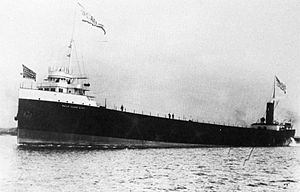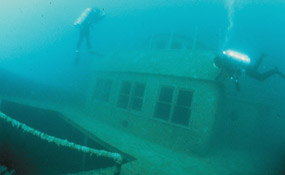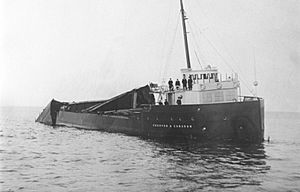SS Chester A. Congdon facts for kids

As the Salt Lake City
|
|
Quick facts for kids History |
|
|---|---|
| Name | Salt Lake City 1907-1911 Chester A. Congdon 1911-1918 |
| Operator |
|
| Builder | Chicago Steam Boat Co. |
| Launched | 1907 |
| Acquired | 1912 |
| Out of service | November 6, 1918 |
| Fate | Sunk on Congdon Shoals, northeast end of Isle Royale in Lake Superior |
| General characteristics | |
| Type | Bulk steel freighter |
| Tonnage | 4843 tons |
| Length | 552 ft (168 m) |
| Beam | 56 ft (17 m) |
| Height | 31 ft (9.4 m) |
| Draft | 26 ft (7.9 m) |
| Installed power | 1,765 hp (1,316 kW) |
| Propulsion | triple expansion steam engine |
| Notes | Official Number 204526 |
|
CHESTER A. CONGDON
|
|

Diving near the pilothouse of the Congdon
|
|
| Location | Congdon Shoals, northeast end of Isle Royale National Park, Michigan |
| Built | 1907 |
| Architect | Chicago Shipbuilding Company |
| Architectural style | Freighter |
| MPS | Shipwrecks of Isle Royale National Park TR |
| NRHP reference No. | 84001716 |
| Added to NRHP | June 14, 1984 |
The Chester A. Congdon was a large steel freighter, which is a ship designed to carry lots of cargo. It was named after a famous lawyer and businessman, Chester Adgate Congdon. The ship was built in 1907 and sadly sank on November 6, 1918, in Lake Superior near Isle Royale. Today, its wreckage rests at the bottom of the lake. In 1984, it was added to the National Register of Historic Places, which means it's an important historical site.
Contents
History of the Chester A. Congdon
The Chester A. Congdon was first built in 1907. It was called the Salt Lake City back then. The ship was constructed by the Chicago Ship Building Co. in Illinois for the Holmes Steamship Company.
This big ship was 552 feet long, which is longer than a football field! It was 56 feet wide and could sit 26 feet deep in the water. It was powered by a strong steam engine that made 1,765 horsepower.
In 1911, the Salt Lake City was sold to a new company. Then, in 1912, it was bought by the Continental Steamship Company. They decided to rename the ship the Chester A. Congdon. This was to honor Chester Adgate Congdon, a well-known lawyer and industrialist from Minnesota. The ship had a fairly calm life, though it did get stuck on the ground twice, once in 1912 and again in 1915.
The Ship's Final Journey
On November 6, 1918, the Congdon left Thunder Bay, Ontario, Canada. It was carrying a huge amount of wheat, about 380,000 bushels! Later that day, the ship ran into thick fog. It accidentally hit some rocks near Isle Royale. These rocks were later named Congdon Shoal because of the accident.
The captain quickly sent out two boats. One went to nearby Passage Island to ask for help. The other boat went back to Thunder Bay to report what happened. Luckily, all the crew members were saved from the ship.
People tried to save the wheat cargo, but only about 20% of it could be recovered. A big storm hit on November 8, just two days later. The storm was so strong that it broke the freighter into two pieces, and the ship sank completely. Another attempt to salvage items from the wreck was made later in 1918, but nothing more was found. The sinking of the Congdon was a very big deal. It was the first time a shipwreck on Lake Superior was worth over a million dollars. It was also the largest loss of cargo and ship size up to that point.
Exploring the Wreck Today
Today, the remains of the Congdon rest deep underwater. The bow (front part) of the ship is in about 50 to 200 feet of water. The stern (back part) is even deeper. The bow section sank upright, which is quite rare for shipwrecks. The pilot house, where the captain steered the ship, is still mostly intact.
Many of the ship's original items were saved before it sank completely. The Congdon wreck is a popular spot for divers. In 2009, about 160 dives were made to explore the Congdon out of over a thousand dives made to all the shipwrecks in Isle Royale National Park.
Images for kids





